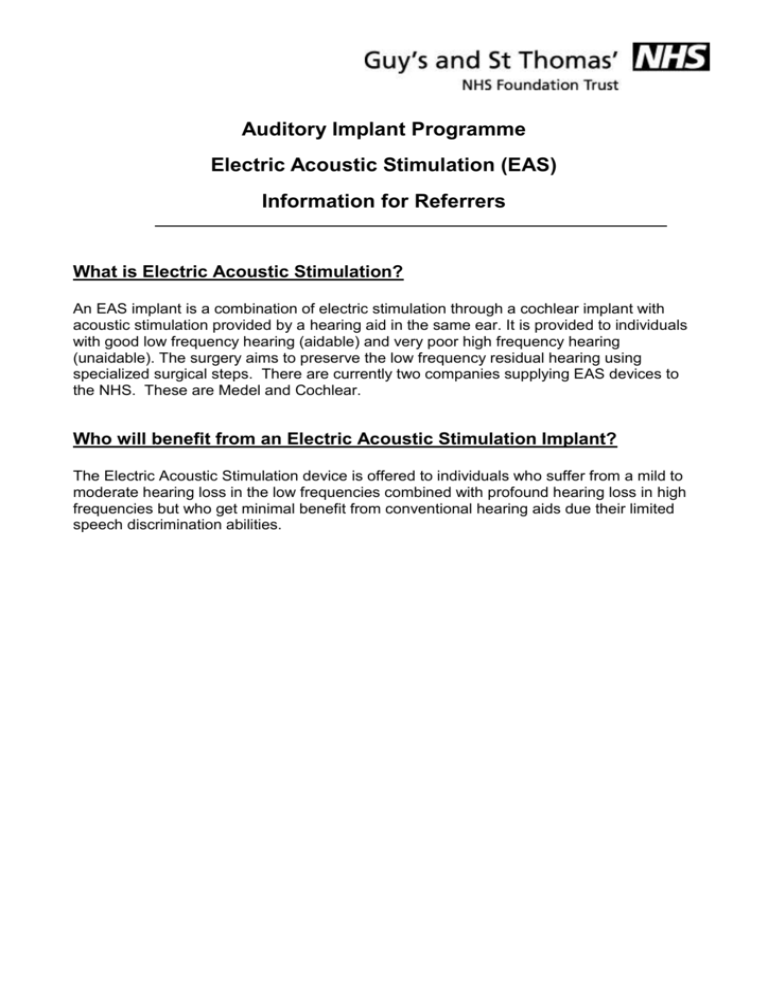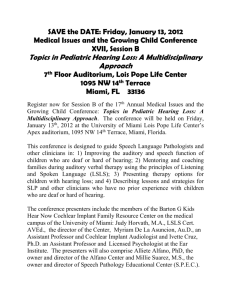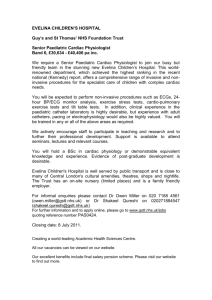
1
Auditory Implant Programme
Electric Acoustic Stimulation (EAS)
Information for Referrers
What is Electric Acoustic Stimulation?
An EAS implant is a combination of electric stimulation through a cochlear implant with
acoustic stimulation provided by a hearing aid in the same ear. It is provided to individuals
with good low frequency hearing (aidable) and very poor high frequency hearing
(unaidable). The surgery aims to preserve the low frequency residual hearing using
specialized surgical steps. There are currently two companies supplying EAS devices to
the NHS. These are Medel and Cochlear.
Who will benefit from an Electric Acoustic Stimulation Implant?
The Electric Acoustic Stimulation device is offered to individuals who suffer from a mild to
moderate hearing loss in the low frequencies combined with profound hearing loss in high
frequencies but who get minimal benefit from conventional hearing aids due their limited
speech discrimination abilities.
27
Page 2 of
Who are the Team Members?
The team is made up of a dedicated multi-disciplinary group of professionals, which
includes:
Consultant ENT Surgeons: Mr Alec Fitzgerald O’Connor, Mr Dan Jiang
Consultant Radiologist: Mr Steve Connor
Audiological Scientists: Mr Terry Nunn, Ms Jennifer Demler, Ms Catherine
Kelleher, Ms Arveni Dooki, Ms Sheena Mclaren, Ms Elaine Burke
Hearing Therapist: Karen Archer
Speech and Language Therapists: Ms Sandra Driver, Ms Emma Stark
Administrators: Ms Susie Altham, Ms Melika Emmanuel, Ms Sandra Allen
ENT Nurses: Carol Kimberlin, Ramon Gamab
How to contact us
Reception
Fax
For an appointment e-mail AIAdmin@gstt.nhs.uk
Firstname.lastname@gstt.nhs.uk (to email individual team members)
(T) 020 7188 6245
020 7188 2192
Published February 2010
37
Page 3 of
What are the referral criteria for the EAS Implant?
Mild to moderate low frequency hearing loss combined with profound high frequency
hearing loss within the specified shaded range (see picture). This is a guide and fitting
range varies slightly between the two companies.
Fitting Range for the Medel Duet EAS (pre-operatively):
Note: The above figure is taken from the Med-El website at:
www.medel.com/eas
Published February 2010
47
Page 4 of
What are the parts of the EAS implant?
The EAS implant system consists of 2 main components: an internal and an external part.
The External Part is a combination of the Speech Processor (electric) and hearing aid
(acoustic) part. It contains the microphone, battery, a digital signal processor, etc. It is held
in place to the head with a magnet. The Speech Processor and hearing aid picks up sound
from the environment, filters the sound into coded signals and then transmits the signal
across the skin to the implant receiver.
The Internal Part is implanted during the surgical procedure. It consists of an internal coil,
a magnet to hold the coil over the implant and houses the electronics of the implant.
Note: The above figure is taken from the Med-El website at:
www.medel.com/eas
What can be expected of the Assessment Process?
This information acts as a guide to the types of assessments that will be made over a
number of appointments. The expected length of assessment from referral to the final
consent appointment is typically 18 weeks, although the assessment may be extended for
many reasons, including patient request or medical reasons. Following the assessment
you will either be listed for surgery or discharged from the clinic. On completion of the
assessment a team report will be sent to the referrer, the patient as well as the other
relevant professionals.
Published February 2010
57
Page 5 of
Initial Screening Appointment
The initial meeting with the Audiological Scientist will involve:
Discussion regarding the assessment process
Discussion of the Electric Acoustic Stimulation implant and issues surrounding
implantation, risks, expectations and potential outcomes
Taking a detailed case history
Audiological testing
Initial ENT Consultation
This is usually done on the same day as the screening appointment. The initial meeting
with the ENT surgeon will involve discussion of:
Medical history
Decisions made regarding further assessments required.
Magnetic Resonance Imaging (MRI) and/or Computer Tomography (CT) may be
booked to check the integrity of the cochleae and hearing nerves
If the patient is suitable to continue then they will undergo the full
assessment.
Further Audiological Assessments
Further clinic appointments will be issued to assess the patients hearing, amplification
needs, and functional aided hearing abilities. The number of appointments required will
vary but will typically include the following:
Hearing Aid Fitting - to optimize your hearing aid setting
Auditory Brainstem Response Test – an objective, non-invasive hearing test
Speech Perception tests
Pre-operative Questionnaires
Speech and Language Assessment
An evaluation of the patients communication skills and the impact your hearing loss has
had will be carried out. Issues surrounding implantation, expectations and outcomes will
also be discussed.
Information Day
The patient will be invited to attend an information day which is open to extended family, to
find out more about electric acoustic stimulation implants. A palentypist will be available
for those who find lip reading problematic.
Team Meeting
Each patient’s management plan is discussed and reviewed at the monthly multidisciplinary team meeting.
Final ENT Consultation
The audiological scientist will accompany the patient for the final appointment with the
ENT surgeon, who will discuss the following:
Medical issues surrounding the EAS implant surgery
Feedback of the scan
Published February 2010
67
Page 6 of
Surgical risks and side effects (temporary taste disturbance, tinnitus, dizziness,
balance impairment, infection, device failure, etc.)
Surgical consent
Once consent is signed the patient will typically be offered an operation slot within 8
weeks. The admissions team will endeavor to give you as much notice as possible.
What is “Soft Surgery”?
“Soft Surgery” is a series of steps taken to maximise the chance of preserving the residual
low frequency hearing by protecting the delicate structures of the cochlear. The EAS
electrode array is shorter than a standard cochlear implant array. The array is inserted
only in the dys-functional, basal region (high frequencies). The insertion depth is
approximately ~18 mm. Residual hearing in the apical region (low frequency sounds) is
stimulated through acoustic amplification.
Note: The above figure is taken from the Med-El website at:
www.medel.com/eas
What ongoing support can be expected following EAS surgery?
The following is an outline of the contact with the team following implantation.
TIMELINE
Surgery
10 days after surgery
4-6 weeks after surgery
1 week after device activation
6 weeks after device activation
3 months after device activation
6 months after device activation
9/12 months after device activation
18 months after device activation
Annual Follow-up visit (as required)
TEAM CONTACT
Guys Hospital
ENT Consultation at St Thomas’ Hospital
Audiological testing
Audiologcial testing
Activation of device over 2 days
Fine tuning and rehabilitation sessions
Fine tuning and rehabilitation sessions
Review session
Review session
Review session and rehabilitation
Review session
Review session
Published February 2010
77
Page 7 of
Further Sources of Information
Additional information regarding Middle Ear Implants can be found on the following
websites:
MEDEL
www.medel.com
Cochlear
www.cochlear.com
Further information
If you have any questions please contact the Auditory Implant Programme on:
Phone 0207 188 6245, Fax 0207 188 2192, e-mail AIAdmin @gstt.nhs.uk.
PALS - To make comments or raise concerns about the Trust’s services, please contact
our Patient Advice and Liaison Service (PALS). Ask a member of staff to direct you to
PALS or:
Published February 2010
t: 020 7188 8801 at St Thomas’ t: 020 7188 8803 at Guy’s e: pals@gstt.nhs.uk
Knowledge & Information Centre (KIC) - For more information about health conditions,
support groups and local services, or to search the internet and send emails, please visit
the KIC on the Ground Floor, North Wing, St Thomas’ Hospital.
t: 020 7188 3416 e: kic@gstt.nhs.uk
Language support services - If you need an interpreter or information about the care you
are receiving in the language or format of your choice, please get in touch using the
following contact details.
t: 020 7188 8815 fax: 020 7188 5953 e: languagesupport@gstt.nhs.uk
NHS Direct - Offers health information and advice from specially trained nurses over the
phone 24 hours a day.
t: 0845 4647 w: www.nhsdirect.nhs.uk
Guy’s and St Thomas’ NHS Foundation Trust
St Thomas’ Hospital, Westminster Bridge Road, London SE1 7EH Guy’s Hospital, Great Maze Pond, London SE1 9RT
Switchboard: 020 7188 7188
www.guysandstthomas.nhs.uk
© 2010 GUY’S AND ST THOMAS’ NHS FOUNDATION TRUST. ALL RIGHTS RESERVED.
Published February 2010









